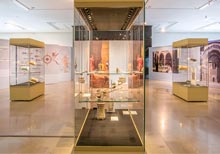Articles
At the end of the 18th century and the beginning of the 19th century, the most famous Bosnian calligrapher was Hafiz Ibrahim Sehovic (d.1812). For many years he was the main imam in Sarajevo Emperor’s Mosque hence his nickname Emperor’s imam.
May 28, 2019
The Bosnian collections are very rich of Islamic manuscripts, and, among them, the transcripts of Qur'an stand out. We singled out five the most famous ones.
May 14, 2019
The exhibition 'Al-Tibb: Healing Traditions in Islamic Medical Manuscripts' seeks to deliver an illustrious journey of the Islamic medicine through a showcase of 73 artefacts, by drawing the focus on medical manuscripts, along with accompanying objects.
May 28, 2018
The honourable work of transcribing the Qur’an has been done through centuries by men and women. One of the less known female scribes lived in the 18th century Sarajevo, in Bosnia and Herzegovina. She signed herself as 'Amina, Mustafa Chelebi's daughter'. Transcribing the Qur'an is the ultimate project for every scribe and calligrapher. There is no doubt that Amina was a good scribe (katiba) and her manuscript has all the elements of the Ottoman classical Mushaf.
Jun 01, 2017
One of the most magnificent Qur’ans ever produced is on display at Chester Beatty Library, Dublin, following extensive conservation work. The Qur’an was created in Shiraz in southwest Iran in the mid-sixteenth century by Ruzbihan Muhammad al-Tab‘i al-Shirazi and a team of illuminators. Ruzbihan was an outstanding calligrapher and this Qur’an is considered to be one of his masterpieces. Only five Qur’ans signed by him have survived and the Chester Beatty treasure is renowned for its quality and significance.
Jul 26, 2016
The Gazi Husrev Beg Library in Sarajevo is hosting an exhibition of the Qur'anic manuscripts from the Oriental Collection of the Historical Archives of Sarajevo.
Jun 14, 2016
SARAJEVO, BiH / On 22rd of December the National and University Library of Bosnia and Herzegovina marked 65 years of its existence with exclusive exhibition of rare Islamic Manuscripts that were saved from fire during the war in BiH.
Dec 25, 2010
The exhibition "Manuscripts of the Qur'an" from the Archives of the Sarajevo City takes place in the historic place called Hanikah, from 16th century, across the Gazi Husrev bei Mosque. The exhibition will be open until the 26th of November 2010.
Nov 21, 2010
SARAJEVO (BiH) / The exhibition "Manuscripts of the Quran" from the Archives of Sarajevo City takes place in hanikah, the historic monument from the 16th century, across the Gazi Husrev Beg Mosque. The exhibition will be open until the 26th of November 2010.
Nov 17, 2010
SARAJEVO (BiH) / The exhibition "Manuscripts of the Qur'an" from the Archives of the Sarajevo City takes place in the historic place called Hanikah, from 16th century, across the Gazi Husrev bei Mosque. The exhibition will be open until the 26th of November 2010.
Nov 14, 2010
SEPTEMBER – OCTOBER 2010
Aug 16, 2010
Istanbul’s Museum of Turkish and Islamic Art is set to host a unique exhibition in honor of the 1,400th anniversary of the revelation of the Quran.
Aug 11, 2010












Stay in touch
Keep up to date with IAM's special offers, giveaways and news in your preferred format.